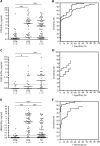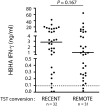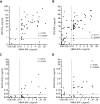Heparin-binding-hemagglutinin-induced IFN-gamma release as a diagnostic tool for latent tuberculosis
- PMID: 17912342
- PMCID: PMC1991599
- DOI: 10.1371/journal.pone.0000926
Heparin-binding-hemagglutinin-induced IFN-gamma release as a diagnostic tool for latent tuberculosis
Abstract
Background: The detection of latent tuberculosis infection (LTBI) is a major component of tuberculosis (TB) control strategies. In addition to the tuberculosis skin test (TST), novel blood tests, based on in vitro release of IFN-gamma in response to Mycobacterium tuberculosis-specific antigens ESAT-6 and CFP-10 (IGRAs), are used for TB diagnosis. However, neither IGRAs nor the TST can separate acute TB from LTBI, and there is concern that responses in IGRAs may decline with time after infection. We have therefore evaluated the potential of the novel antigen heparin-binding hemagglutinin (HBHA) for in vitro detection of LTBI.
Methodology and principal findings: HBHA was compared to purified protein derivative (PPD) and ESAT-6 in IGRAs on lymphocytes drawn from 205 individuals living in Belgium, a country with low TB prevalence, where BCG vaccination is not routinely used. Among these subjects, 89 had active TB, 65 had LTBI, based on well-standardized TST reactions and 51 were negative controls. HBHA was significantly more sensitive than ESAT-6 and more specific than PPD for the detection of LTBI. PPD-based tests yielded 90.00% sensitivity and 70.00% specificity for the detection of LTBI, whereas the sensitivity and specificity for the ESAT-6-based tests were 40.74% and 90.91%, and those for the HBHA-based tests were 92.06% and 93.88%, respectively. The QuantiFERON-TB Gold In-Tube (QFT-IT) test applied on 20 LTBI subjects yielded 50% sensitivity. The HBHA IGRA was not influenced by prior BCG vaccination, and, in contrast to the QFT-IT test, remote (>2 years) infections were detected as well as recent (<2 years) infections by the HBHA-specific test.
Conclusions: The use of ESAT-6- and CFP-10-based IGRAs may underestimate the incidence of LTBI, whereas the use of HBHA may combine the operational advantages of IGRAs with high sensitivity and specificity for latent infection.
Conflict of interest statement
Figures



Similar articles
-
[Evolution of IGRA researches].Kekkaku. 2008 Sep;83(9):641-52. Kekkaku. 2008. PMID: 18979999 Review. Japanese.
-
[Characteristics of a diagnostic method for tuberculosis infection based on whole blood interferon-gamma assay].Kekkaku. 2006 Nov;81(11):681-6. Kekkaku. 2006. PMID: 17154047 Review. Japanese.
-
Contribution of a heparin-binding haemagglutinin interferon-gamma release assay to the detection of Mycobacterium tuberculosis infection in HIV-infected patients: comparison with the tuberculin skin test and the QuantiFERON-TB Gold In-tube.BMC Infect Dis. 2015 Feb 14;15:59. doi: 10.1186/s12879-015-0796-0. BMC Infect Dis. 2015. PMID: 25886172 Free PMC article.
-
Optimal Detection of Latent Mycobacterium tuberculosis Infection by Combined Heparin-Binding Hemagglutinin (HBHA) and Early Secreted Antigenic Target 6 (ESAT-6) Whole-Blood Interferon Gamma Release Assays.J Clin Microbiol. 2022 May 18;60(5):e0244321. doi: 10.1128/jcm.02443-21. Epub 2022 Apr 18. J Clin Microbiol. 2022. PMID: 35430897 Free PMC article.
-
Commercially available CD4 + and CD8 + IFN-γ release assays combined with an HBHA-induced IGRA improve the characterization of the tuberculosis spectrum and monitoring of treatment in children.Eur J Pediatr. 2023 May;182(5):2155-2167. doi: 10.1007/s00431-023-04844-1. Epub 2023 Feb 27. Eur J Pediatr. 2023. PMID: 36847873 Free PMC article.
Cited by
-
Immune responses in the lungs of patients with tuberculous pleural effusion without pulmonary tuberculosis.BMC Immunol. 2012 Aug 13;13:45. doi: 10.1186/1471-2172-13-45. BMC Immunol. 2012. PMID: 22889060 Free PMC article.
-
An immunoinformatics approach to design a multi-epitope vaccine against Mycobacterium tuberculosis exploiting secreted exosome proteins.Sci Rep. 2021 Jul 5;11(1):13836. doi: 10.1038/s41598-021-93266-w. Sci Rep. 2021. PMID: 34226593 Free PMC article.
-
Recent Trends in System-Scale Integrative Approaches for Discovering Protective Antigens Against Mycobacterial Pathogens.Front Genet. 2018 Nov 27;9:572. doi: 10.3389/fgene.2018.00572. eCollection 2018. Front Genet. 2018. PMID: 30538722 Free PMC article. Review.
-
Tuberculosis Transmission in a Primary School and a Private Language School. An Estimation of Infectivity.Front Pediatr. 2020 Feb 7;8:10. doi: 10.3389/fped.2020.00010. eCollection 2020. Front Pediatr. 2020. PMID: 32117825 Free PMC article.
-
Age-Stratified T Cell Responses in Children Infected with Mycobacterium tuberculosis.Front Immunol. 2017 Sep 5;8:1059. doi: 10.3389/fimmu.2017.01059. eCollection 2017. Front Immunol. 2017. PMID: 28928738 Free PMC article.
References
-
- 2007. WORLD HEALTH ORGANIZATION Tuberculosis fact sheet n° 104, revised march 2007. www.who.int/mediacentre/factsheets/fs104/en/
-
- Dye C. Global Epidemiology of tuberculosis. Lancet. 2006;367:938–940. - PubMed
-
- Jasmer RM, Nahid P, Hopewell PC. Clinical practice : latent tuberculosis infection. N Engl J Med. 2002;347:1860–1866. - PubMed
-
- Sterling TR, Haas DW. Transmission of Mycobacterium tuberculosis from health care workers. N Engl J Med. 2006;355:118–121. - PubMed
-
- Whalen CC, Johnson JL, Okwera A, Hom DJ, et al. A trial of three regimens to prevent tuberculosis in Ugandan adults infected with the human immunodeficiency virus. Uganda-Case Western Reserve University Research Collaboration. N Engl J Med. 1997;337:801–808. - PubMed
Publication types
MeSH terms
Substances
LinkOut - more resources
Full Text Sources
Other Literature Sources
Medical
Miscellaneous

